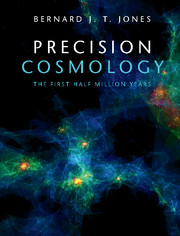Book contents
- Frontmatter
- Dedication
- Contents
- Preface
- Notation and Conventions
- Part I 100 Years of Cosmology
- Part II Newtonian Cosmology
- Part III Relativistic Cosmology
- Part IV The Physics of Matter and Radiation
- Part V Precision Tools for Precision Cosmology
- 23 Likelihood
- 24 Frequentist Hypothesis Testing
- 25 Statistical Inference: Bayesian
- 26 CMB Data Processing
- 27 Parameterising the Universe
- 28 Precision Cosmology
- 29 Epilogue
- Appendix A SI, CGS and Planck Units
- Appendix B Magnitudes and Distances
- Appendix C Representing Vectors and Tensors
- Appendix D The Electromagnetic Field
- Appendix E Statistical Distributions
- Appendix F Functions on a Sphere
- Appendix G Acknowledgements
- References
- Index
28 - Precision Cosmology
from Part V - Precision Tools for Precision Cosmology
Published online by Cambridge University Press: 04 May 2017
- Frontmatter
- Dedication
- Contents
- Preface
- Notation and Conventions
- Part I 100 Years of Cosmology
- Part II Newtonian Cosmology
- Part III Relativistic Cosmology
- Part IV The Physics of Matter and Radiation
- Part V Precision Tools for Precision Cosmology
- 23 Likelihood
- 24 Frequentist Hypothesis Testing
- 25 Statistical Inference: Bayesian
- 26 CMB Data Processing
- 27 Parameterising the Universe
- 28 Precision Cosmology
- 29 Epilogue
- Appendix A SI, CGS and Planck Units
- Appendix B Magnitudes and Distances
- Appendix C Representing Vectors and Tensors
- Appendix D The Electromagnetic Field
- Appendix E Statistical Distributions
- Appendix F Functions on a Sphere
- Appendix G Acknowledgements
- References
- Index
Summary
While the CMB experiments have played a central role in setting precise values for many cosmological parameters, there are other astronomical datasets which can, by themselves, produce remarkably precise results, in particular the Type Ia supernovae (SN Ia) and the baryon acoustic oscillations (BAO). Bringing these together will both serve as mutual confirmation and generally reduce the errors in the estimates of the parameters. This may also highlight areas of tension or discord between estimates of some parameters.
It is important to realise that, had the CMB data not been taken, we would almost certainly have measured the values of the cosmological parameters, possibly with comparable accuracy in many cases, by studying distant objects, e.g. supernovae, and huge catalogues of galaxy positions and redshifts. What is scientifically important is that the CMB data analysis largely rests on a foundation that is based in the physics of the early Universe.
With CMB data, we calibrate fundamental cosmic-length scales by understanding the physics of the power spectrum of the temperature fluctuations, which arise mostly in a narrow redshift band around the time when the Universe was becoming neutral. In contrast, the astronomical determinations tend to be based on calibrations of distant data by detailed understanding of relatively nearer objects, and rarely, if ever, make reference to the CMB.
This duality of approaches is powerful evidence that we are not being somehow fooled by something unknown when coming to our conclusions: the approaches are mutually corroborative. So far there is compelling evidence from both approaches for the existence of copious amounts of both dark matter and for dark energy. Both approaches will play a part in coming to terms with these two great unknowns.
Observing the Universe
The increased level of precision with which we can determine the parameters that define our Universe has grown as a result of research by thousands of astronomers and physicists. Although a few lines of research have grown to dominate our thinking in regard to cosmological parameters, we have only arrived at that point due to efforts in a large number of different explorations. The culmination of that effort was perhaps the discovery of the acceleration of the cosmic expansion, and the subsequent efforts to pin down the properties of the expansion using high-precision techniques.
- Type
- Chapter
- Information
- Precision CosmologyThe First Half Million Years, pp. 645 - 669Publisher: Cambridge University PressPrint publication year: 2017



